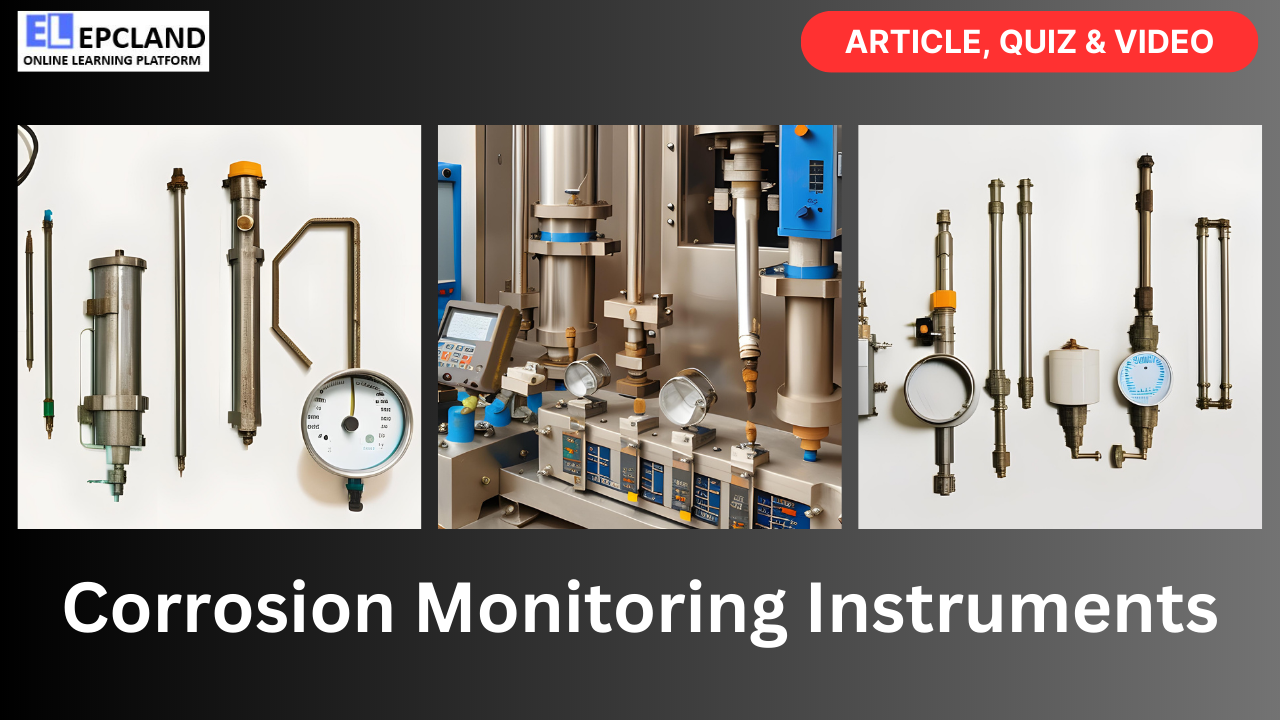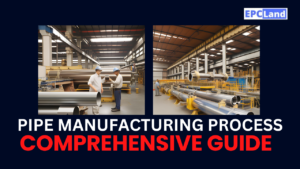Corrosion poses a significant challenge to the Oil & Gas Industry. The harsh environments, the presence of corrosive substances, and the high pressures and temperatures create ideal conditions for corrosion to occur. To combat this costly issue, the industry relies heavily on corrosion monitoring instruments. These instruments play a crucial role in detecting, assessing, and mitigating corrosion in various components and structures within oil and gas projects. In this article, we will delve into the world of corrosion monitoring instruments, exploring their types, applications, working principles, and importance in safeguarding the integrity of critical assets.
Table of Contents
Do not miss the Complete Course on Piping Engineering
By EPCLand
Understanding Corrosion in Oil & Gas
What is Corrosion?
Corrosion is a natural process that involves the deterioration of materials, typically metals, due to chemical reactions with their environment. In the context of the Oil & Gas Industry, corrosion occurs when metal equipment and infrastructure are exposed to harsh conditions, including:
- Hydrogen sulfide (H2S) and carbon dioxide (CO2), both of which are common in oil and gas reservoirs, can lead to sulfide stress cracking and localized corrosion.
- High temperatures and pressures, which can accelerate corrosion processes.
- Moisture, which creates a corrosive environment.
- Abrasion, which can remove protective coatings.
The Cost of Corrosion
Corrosion is not only a safety concern but also a major financial burden for the Oil & Gas Industry. It leads to equipment failures, unplanned downtime, and expensive repairs. According to the National Association of Corrosion Engineers (NACE), the global cost of corrosion is estimated to be over $2.5 trillion annually.
The Role of Corrosion Monitoring Instruments
To combat the detrimental effects of corrosion, the Oil & Gas Industry relies on a variety of corrosion monitoring instruments. These instruments serve several critical functions:
Early Detection of Corrosion
Corrosion monitoring instruments allow for the early detection of corrosion before it progresses to a critical stage. This early warning enables proactive maintenance and mitigation measures, preventing costly equipment failures.
Data Collection and Analysis
Corrosion monitoring instruments continuously collect data about corrosion rates, material loss, and the condition of assets. This data is analyzed to make informed decisions about maintenance and asset integrity.
Regulatory Compliance
Many oil and gas projects must adhere to strict environmental and safety regulations. Corrosion monitoring instruments help ensure compliance by tracking corrosion rates and verifying the integrity of critical components.
Cost Savings
By identifying and addressing corrosion issues promptly, corrosion monitoring instruments help reduce maintenance costs, extend the lifespan of equipment, and minimize downtime.
Types of Corrosion Monitoring Instruments
There is a wide range of corrosion monitoring instruments employed in the Oil & Gas Industry. Each type serves a specific purpose and is suited to different applications.
1. Electrochemical Corrosion Sensors
Electrochemical corrosion sensors are among the most widely used instruments for corrosion monitoring. They work based on the principle of measuring the electrical currents generated by the corrosion process. Common types of electrochemical sensors include:
– Electrochemical Noise (ECN) Sensors: These sensors detect fluctuations in electrical potential or current caused by corrosion. They are suitable for detecting localized corrosion.
– Potentiostatic and Galvanostatic Sensors: These sensors control the electrode potential or current to maintain a constant value, allowing for precise measurements of corrosion rates.
Working Principle: Electrochemical sensors measure the current or potential difference generated as a result of electrochemical reactions occurring at the metal surface due to corrosion. The rate of corrosion is proportional to the measured electrical signal.
2. Corrosion Coupons and Probes
Corrosion coupons are sacrificial metal strips or coupons that are placed in the process fluid or on the surface of equipment. Over time, these coupons corrode, and their weight loss is used to calculate the corrosion rate. Probes work on a similar principle but are often more complex and capable of providing real-time data.
Working Principle: Corrosion coupons and probes rely on the weight loss or material thickness reduction due to corrosion. Periodic measurements are taken, and the corrosion rate is calculated based on the change in weight or thickness.
3. Ultrasonic Thickness Gauges
Ultrasonic thickness gauges use sound waves to measure the thickness of a material. By periodically measuring the thickness of metal components, these gauges can detect corrosion-induced thinning.
Working Principle: Ultrasonic thickness gauges send high-frequency sound waves into the material. The time it takes for the sound waves to bounce back is used to calculate the thickness of the material. Corrosion-induced thinning results in a reduction in thickness, which is detected by the instrument.
4. Electromagnetic Corrosion Sensors
Electromagnetic corrosion sensors use electromagnetic fields to detect changes in the conductivity or permeability of a material, which can indicate the presence of corrosion.
Working Principle: These sensors measure changes in the electromagnetic properties of the material caused by corrosion. Corrosion leads to alterations in electrical conductivity or magnetic permeability, which are detected by the instrument.
5. Fiber Optic Sensors
Fiber optic sensors are ideal for monitoring corrosion in hard-to-reach or hazardous environments. They work by measuring changes in the reflection or transmission of light through optical fibers caused by corrosion-induced strain or changes in the material’s properties.
Working Principle: Fiber optic sensors rely on the principle of changes in light transmission or reflection due to corrosion-induced strain or alterations in the material’s refractive index. These changes are detected by optical sensors.
6. Corrosion Rate Meters
Corrosion rate meters are portable devices that provide real-time measurements of corrosion rates. They are often used for on-site corrosion monitoring and assessment.
Working Principle: Corrosion rate meters typically measure the rate of material loss over time. Some employ electrochemical methods, while others use ultrasonic or magnetic principles to assess corrosion rates.
7. Remote Corrosion Monitoring Systems
These systems utilize a network of sensors and data communication technologies to monitor corrosion remotely. They are particularly valuable for offshore and remote oil and gas installations.
Working Principle: Remote corrosion monitoring systems employ various sensor technologies, including electrochemical, ultrasonic, and electromagnetic, to continuously collect data on corrosion rates. This data is transmitted to a central monitoring station for analysis.
Do not miss the Complete Course on Piping Engineering
By EPCLand
Applications of Corrosion Monitoring Instruments
Corrosion monitoring instruments find application across various sectors within the Oil & Gas Industry, each with its unique challenges and requirements.
1. Production and Drilling
In the production and drilling phases, corrosion monitoring is crucial for assessing the integrity of well casings, pipelines, and downhole equipment. Monitoring instruments are used to detect corrosive conditions in reservoirs and wells.
2. Refineries and Petrochemical Plants
Refineries and petrochemical plants are highly susceptible to corrosion due to the aggressive nature of the chemicals processed. Instruments are employed to monitor corrosion in pipes, vessels, heat exchangers, and storage tanks.
3. Pipelines and Transportation
Pipelines are the lifelines of the Oil & Gas Industry. Corrosion monitoring instruments play a vital role in ensuring the safety and integrity of pipelines, detecting corrosion, and facilitating timely maintenance and repair.
4. Offshore and Subsea
Offshore and subsea installations face extreme environmental conditions, making corrosion a significant concern. Instruments are used to monitor underwater structures, pipelines, and subsea equipment.
5. Storage Tanks
Corrosion monitoring instruments are essential for assessing the condition of storage tanks used for storing crude oil and various petroleum products. They help prevent leaks and environmental contamination.
Importance of Real-Time Monitoring
While periodic corrosion assessments are valuable, real-time monitoring is increasingly essential in the Oil & Gas Industry. Real-time data allows for immediate response to changing conditions, ensuring the safety and integrity of assets. Here are some key reasons why real-time monitoring is crucial:
Early Detection
Real-time monitoring enables the immediate detection of corrosion events, allowing for timely interventions to prevent asset failure or environmental damage.
Predictive Maintenance
Continuous monitoring provides data that can be used to predict when equipment or structures are likely to require maintenance, reducing downtime and improving efficiency.
Condition-Based Monitoring
Real-time data allows for condition-based monitoring, where maintenance activities are triggered based on the actual condition of assets rather than fixed schedules.
Environmental Protection
In the event of a corrosion-related leak or failure, real-time monitoring can trigger immediate shutdowns or isolation, preventing environmental disasters and minimizing cleanup costs.
Advantages and Disadvantages of Corrosion Monitoring Instruments
| Advantages | Disadvantages |
|---|---|
| Early detection of corrosion events | Initial setup and installation costs |
| Data-driven decision-making | Regular maintenance and calibration required |
| Regulatory compliance | Variability in accuracy between instruments |
| Cost savings through proactive maintenance | Limited coverage in hard-to-reach areas |
| Real-time monitoring for immediate response | Data overload and management complexities |
| Predictive maintenance for reduced downtime | Data security and privacy concerns |
| Improved environmental protection | Sensor susceptibility to harsh environments |
| Condition-based monitoring for efficient maintenance | Potential for false alarms and alerts |
Challenges and Emerging Trends
Despite the advancements in corrosion monitoring instruments, the Oil & Gas Industry faces several challenges in managing corrosion effectively:
1. Harsh Environments
Oil and gas operations often take place in extreme environments, including offshore, subsea, and high-temperature locations. Corrosion monitoring instruments must be rugged and reliable to withstand these conditions.
2. Data Management
The vast amount of data generated by corrosion monitoring instruments requires efficient data management systems and analytics tools to extract valuable insights.
3. Integration with Asset Management Systems
Corrosion monitoring must be seamlessly integrated with asset management systems to ensure that maintenance and repair activities are prioritized correctly.
4. Corrosion Under Insulation (CUI)
Corrosion under insulation is a particularly challenging issue in the industry. Monitoring instruments capable of detecting CUI are essential for preventing hidden corrosion.
5. Material Selection and Coatings
Advancements in materials science and protective coatings are critical in reducing corrosion rates. Corrosion monitoring instruments can help assess the effectiveness of these materials.
6. Automation and AI
Automation and artificial intelligence (AI) are emerging trends in corrosion monitoring. AI algorithms can analyze vast amounts of data to predict corrosion rates and optimize maintenance strategies.
Do not miss the Complete Course on Piping Engineering
By EPCLand
Conclusion
Corrosion is a pervasive and costly issue in the Oil & Gas Industry. However, with the use of advanced corrosion monitoring instruments, the industry can proactively manage and mitigate corrosion-related risks. These instruments enable early detection, data-driven decision-making, and cost-effective maintenance strategies.
As the industry continues to evolve, the integration of real-time monitoring, automation, and AI-driven analytics will play an increasingly vital role in safeguarding critical assets and reducing the environmental impact of oil and gas operations. By staying at the forefront of corrosion monitoring technology, the Oil & Gas Industry can continue to ensure the safe and efficient production and transportation of hydrocarbons to meet global energy demands.
FAQs
1. What is the primary purpose of corrosion monitoring instruments in the Oil & Gas Industry?
- Corrosion monitoring instruments are primarily used to detect, assess, and mitigate corrosion in various components and structures within oil and gas projects. They play a crucial role in ensuring the safety, integrity, and efficiency of assets by providing early warnings of corrosion-related issues.
2. What are the common types of corrosion monitoring instruments used in the industry?
- Common types of corrosion monitoring instruments include electrochemical corrosion sensors, corrosion coupons and probes, ultrasonic thickness gauges, electromagnetic corrosion sensors, fiber optic sensors, corrosion rate meters, and remote corrosion monitoring systems. Each type serves specific purposes and applications.
3. How does real-time monitoring differ from periodic corrosion assessments?
- Real-time monitoring involves continuous data collection and immediate response to corrosion events as they occur. In contrast, periodic assessments are scheduled inspections conducted at intervals. Real-time monitoring allows for early detection and immediate action, while periodic assessments offer a snapshot of corrosion conditions at a specific moment.
4. What are the advantages of using corrosion monitoring instruments in the Oil & Gas Industry?
- The advantages of corrosion monitoring instruments include early detection of corrosion events, data-driven decision-making, regulatory compliance, cost savings through proactive maintenance, real-time monitoring for immediate response, predictive maintenance for reduced downtime, improved environmental protection, and condition-based monitoring for efficient maintenance.
5. What are some of the challenges faced in the application of corrosion monitoring instruments in the industry?
- Challenges in corrosion monitoring include operating in harsh environments, managing and analyzing vast amounts of data, integrating with asset management systems, detecting corrosion under insulation (CUI), selecting appropriate materials and coatings, and addressing issues related to automation and AI adoption in corrosion monitoring. These challenges require careful consideration for effective corrosion management.
Recommended courses (Published on EPCLand)
- Basics of Piping Engineering
- Piping Layout Engineering
- Piping Material Engineering
- Piping Stress Analysis
- Complete Course on Piping Engineering
- Material Requisitions
- Piping Material Specifications
- Valve Material Specifications
Don’t miss the published articles on following:
| Data Analysis and Technology with Link | Data Analysis and Technology with Link |
| Data Analytics | Industrial Control Networks |
| Machine Learning | The Power of Acoustic Sensors |
Do not miss the Complete Course on Piping Engineering
By EPCLand
Related Video
Attempt Quiz
Question 1:
What is a common method for monitoring corrosion in oil & gas pipelines?
Explanation: Visual inspections are a common method for monitoring corrosion in oil & gas pipelines.
Question 2:
What type of corrosion monitoring instrument measures the thickness of metal surfaces?
Explanation: An ultrasonic thickness gauge is used to measure the thickness of metal surfaces and monitor corrosion.
Question 3:
Which instrument is commonly used for continuous monitoring of corrosion rates in pipelines?
Explanation: Corrosion probes are commonly used for continuous monitoring of corrosion rates in pipelines.
Question 4:
Which corrosion monitoring technique relies on the measurement of electrical potential?
Explanation: Polarization resistance measurement relies on the measurement of electrical potential and is a corrosion monitoring technique.
Question 5:
Which instrument is used to monitor the effectiveness of cathodic protection systems?
Explanation: Rectifiers are used to monitor the effectiveness of cathodic protection systems in preventing corrosion.



